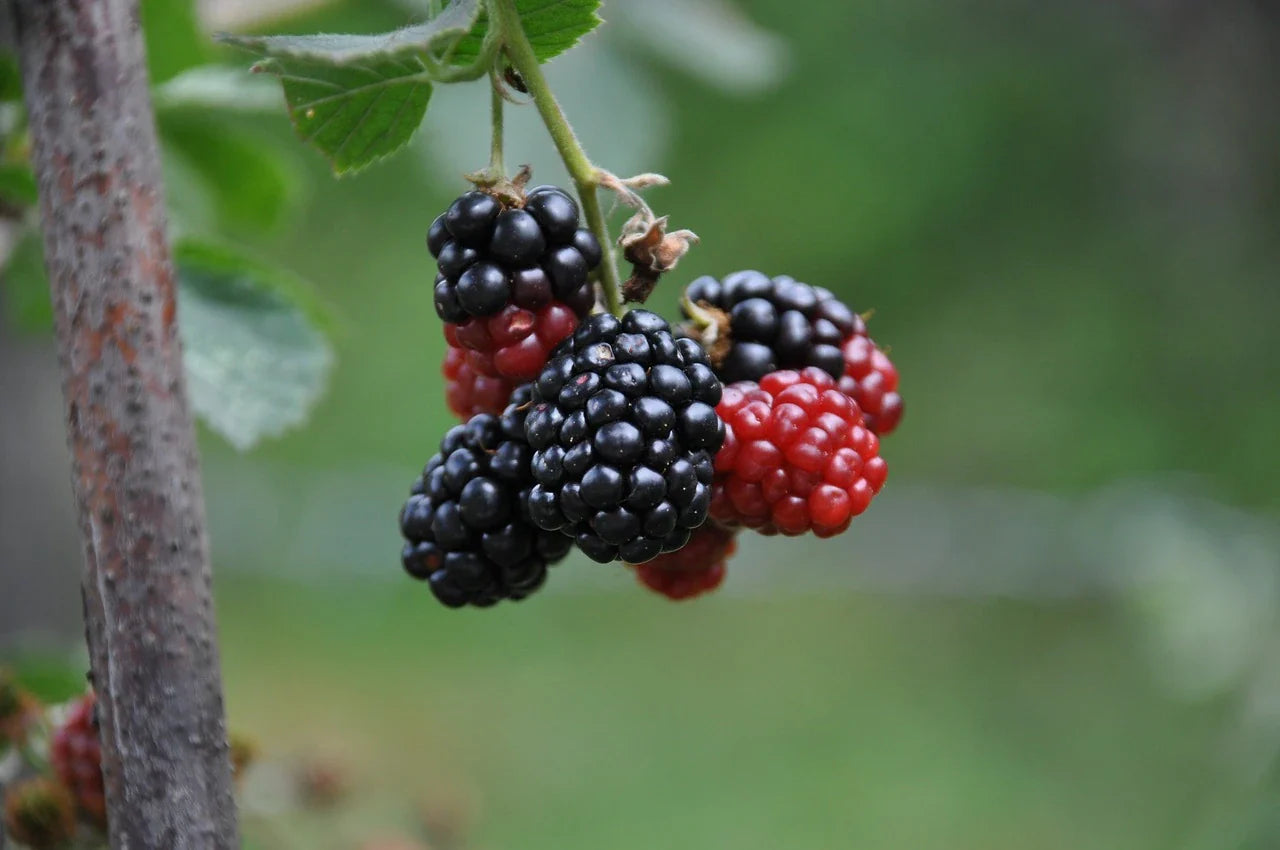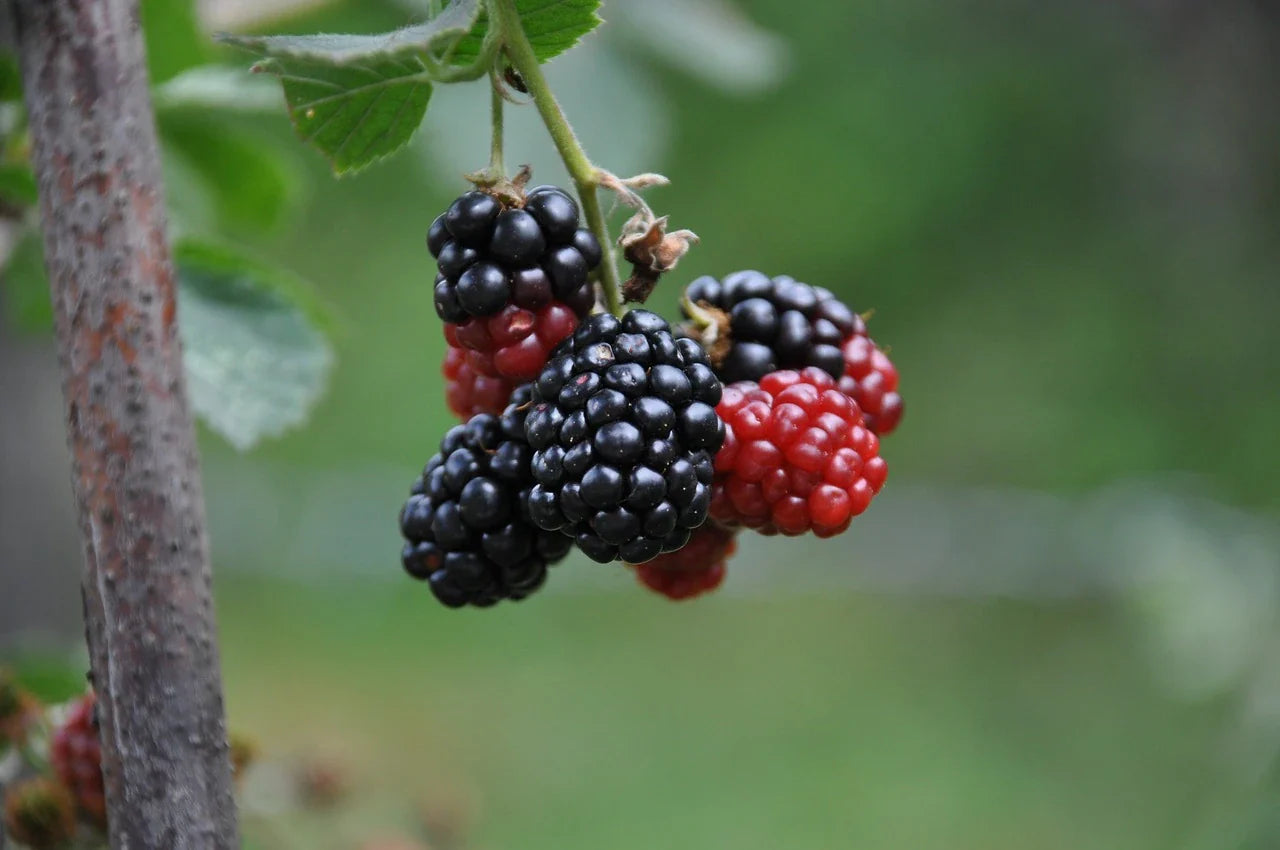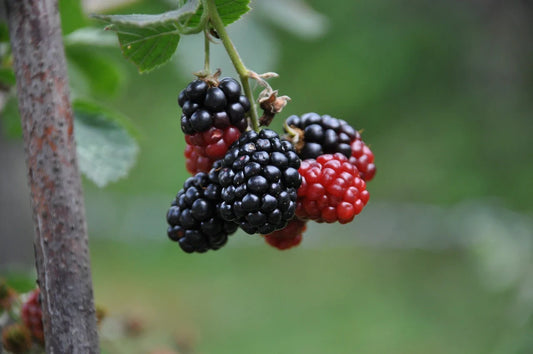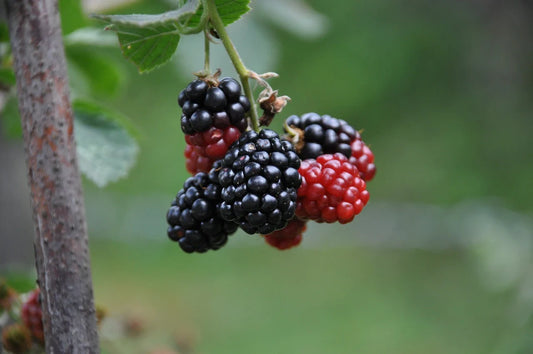-
Delivery from 10 plants within 15 days FR/ EU / CH
Delivery Terms -
Wholesale Supplier of Small Fruit Plants
About Us -
Quality Small Fruit Plants
Technical itinerary for small fruits -
Secure payment
Our Payment Terms
Organic Mulberry Loch Ness Plant - 2L pot, 60cm tall
Organic Mulberry Loch Ness Plant - 2L pot, 60cm tall
Price € excluding VAT per unit excluding transport. Our prices are based on volume. We offer you the best option based on your needs.
Couldn't load pickup availability
 Buy now and get it delivered when you're ready to plant - Add your desired date to your quote request
Buy now and get it delivered when you're ready to plant - Add your desired date to your quote request
 Delivery from 10 plants within 15 days FR/ EU / CH
Delivery from 10 plants within 15 days FR/ EU / CH
When to Plant / When to Harvest Mulberry Trees?
Do you want to grow blackberries but don't know when to plant them? Do you want to know when you'll harvest them? Check out our Mulberry Planting and Harvesting Calendar
View full details
Loch Ness Mulberry plants at producer prices for professional market gardeners
Loch Ness Mulberry Variety Fact Sheet
- Fruit flesh color: Juicy, with an estimated juice content of 80 to 85% of the fresh weight of the fruit.
- Skin color: Shiny black, very dark. Some fruits may have purple highlights depending on exposure and ripeness.
- Size and shape: Large to very large (4 to 5 grams on average), elongated in shape. The fruit is generally 3 to 4 cm long and 1 to 2 cm in diameter.
- Tree Size: Typically reaches between 1.5 and 2 meters in height, up to 3 meters depending on training and trellising. The width can reach up to 3 meters. The growth habit is semi-erect to climbing.
- Fruit ripeness: Mainly in August and September, but can extend into October. Harvesting is staggered.
- Fruit Taste: Sweet, slightly acidic, and fragrant. It starts out tangy, evolving into a sweet, aromatic flavor at full maturity. The sugar/acidity balance is considered superior to many other large-bore varieties. The reference Brix level is between 9° and 12°, with an optimum between 10° and 12°. The flesh is firm and juicy.
- Earliness of the variety: Non-remontant variety ("floricane"), fruiting on the wood of the previous year.
- Fruiting period From August to early October.
- Disease resistance and storage: Good overall resistance to common mulberry diseases and low susceptibility to brown rot (fruit rot). Tolerates winter temperatures down to -15°C to -18°C. Excellent post-harvest storage due to firm fruit. Good tolerance to rain.
- Variety yield: High. Typically between 3 and 5 kg per mature plant. Potentially up to 15 tonnes per hectare under optimal conditions. A yield of 10 to 12 tonnes/ha is realistic in France for well-managed plantations.
- Is this variety self-fertile? Yes, self-fertile. A single plant is enough for good production. Cross-pollination is not necessary.
- Commercial use: Suitable for fresh consumption (taste and visual quality) and for processing (jams, jellies, pastries, juices, syrups, freezing). Good suitability for mechanical harvesting.
- Comments: Thornless variety (*Rubus fruticosus* 'Loch Ness'). Greatly facilitates manual and potentially mechanized harvesting. Requires training to optimize harvesting and plant management. Native to England. Good tolerance to calcareous soils, up to a certain level (active limestone ≤ 7%). Good to moderate drought tolerance, but irrigation is recommended in case of prolonged drought. Productive lifespan of 12 to 15 years. Flowering from May to June, white-pink flowers attractive to bees (honey variety). First significant harvest 2 years after planting.
Quick read / the essentials on Loch Ness Mulberry
The Loch Ness Mulberry is today an essential reference for any fruit farm focused on the production of quality thornless blackberries. This variety, developed in Scotland in the 1990s, is attractive for its balance between productivity, hardiness and commercial quality. Thanks to its European origin, it adapts perfectly to French climatic conditions, which makes it a safe bet for producers. As a specialist wholesale supplier of mulberry plants , Bairiverse highlights this high-performance variety, both in intensive professional cultivation and for direct sales or processing channels.
Thornless, easy to train and very vigorous, it produces very large (up to 5 g), elongated, shiny black, sweet and low-acid fruits. Their excellent post-harvest stability makes them ideal for long circuits or freezing. The Loch Ness mulberry tree is self-fertile, productive (up to 15 tonnes/ha) and not very susceptible to disease. It begins production in the second year, with a productive lifespan of 12 to 15 years.
As a specialist wholesale supplier of mulberry plants , Bairiverse supports market gardeners in choosing high-performance varieties, with appropriate technical monitoring and advice on management. For those wishing to purchase Loch Ness mulberry plants , Bairiverse offers batches available to order, at the best quality-price ratio. Take advantage of our team's field expertise to integrate this European standard into your orchard.
Would you like to buy Loch Ness mulberry plants with confidence? Our role as a specialist wholesale supplier of mulberry plants is to guarantee you optimal quality, for a sustainable, profitable crop that can be sold in a variety of channels.
Origin and agronomic interest
The Loch Ness mulberry (Rubus fruticosus 'Loch Ness') is a thornless variety developed in Scotland in the 1990s. Unlike many American varieties, it is a European strain, perfectly adapted to the climate and growing requirements in France. Its thornlessness makes it a particularly easy variety to harvest , both by hand and for semi-mechanized harvesting.
Today it is one of the most widely cultivated mulberry varieties in Europe , particularly due to its balance between vigour, productivity and fruit quality.
Fruit characteristics
The fruit of the Loch Ness mulberry tree is a major asset for professionals. It is very large , with an average weight of 4 to 5 grams , a length of 3 to 4 cm and a diameter of 1 to 2 cm . Its elongated shape , its shiny black skin when ripe, sometimes with purple highlights, and its firmness make it a particularly attractive fruit from a commercial point of view.
The flavor is sweet, balanced, slightly acidic at the beginning of maturity then aromatic and sweet at full maturity. The sugar level (Brix) is generally between 10° and 12° , a sign of excellent taste potential. The fruit is juicy , with low acidity, suitable for fresh consumption as well as for processing (juice, jams, pastries, freezing).
The fruits have excellent post-harvest shelf life . Their firm texture facilitates transport and conservation , a determining factor for long-distance sales.
Fruiting and precocity
The variety is non-remontant (floricane), that is to say that fruiting takes place on the wood of the previous year . Flowering takes place from May to June , and the main harvest is spread from August to September , or even October depending on climatic conditions. It is progressive , which allows the picking to be spread over several weeks.
The Loch Ness mulberry tree is self-fertile : no other plant is required to obtain a bountiful harvest.
Agronomic behavior
The plant reaches an adult height of 1.5 to 3 meters , depending on training. The habit is semi-erect to climbing , which makes trellising essential : a system of 2 to 3 wires stretched at a height of 1.5 to 2 meters is recommended. This system facilitates harvesting, improves ventilation and limits humidity-related diseases.
The variety has vigorous growth and a bushy but compact development . It comes into production from the 2nd year after planting , with a productive lifespan of 12 to 15 years .
Resistance and adaptation
The Loch Ness mulberry tree is distinguished by its good overall resistance to diseases , particularly the main fungal diseases of mulberry trees. It is not very susceptible to brown rot , which helps to limit harvest losses.
Regarding growing conditions, this variety tolerates drought well , provided that it is irrigated during prolonged periods. It adapts to most neutral to slightly acidic , well-drained soils. It can be susceptible to root asphyxiation if the soil is too compact or poorly drained.
Cultivation on ungrafted soil is the most common and recommended method. No specific rootstock is required.
Performance and commercial valuation
Under professional conditions, the yield per adult plant is generally 3 to 5 kg , with peaks of up to 5 kg and more in intensive cultivation. The yield per hectare is estimated at between 5 and 15 tonnes , with a realistic target of 10 to 12 tonnes/ha in France for a well-managed crop.
The fruits of Loch Ness lend themselves to various commercial outlets :
-
Fresh consumption , thanks to their size, their visual appearance and their pleasant taste
-
Food processing , into jam, jelly, juice, syrup, pastries
-
Freezing , thanks to their good resistance
Conclusion
The Loch Ness mulberry tree offers an excellent compromise between yield, hardiness, fruit quality and ease of management . It is particularly recommended for French farms wishing to promote the production of thornless blackberries, suitable for direct sales, distribution or food processing . Thanks to its versatility , it constitutes a reference among professional varieties of mulberry trees .
To summarize: Loch Ness Mulberry
The Loch Ness Mulberry ticks all the boxes for profitable and simplified cultivation: thornless, very large, firm and juicy fruits, staggered harvest, high productivity and very good post-harvest stability. This floricane variety (fruiting on wood from the previous year) is perfectly suited to professional cultivation in France. Its vigor and hardiness are assets for regular, sustainable production with few constraints.
Thanks to its taste qualities (10 to 12 °Brix) and its versatility (fresh, processing, freezing), it meets the expectations of the French and European markets. Training on wires is recommended to get the most out of its semi-erect shape. In well-drained soil, with irrigation if necessary, this mulberry tree gives its best from the 2nd year. For farms looking for a stable, high-quality variety with little susceptibility to disease, it is a strategic choice.
Bairiverse , your specialist wholesale supplier of mulberry plants , rigorously selects Loch Ness plants to ensure each grower receives optimal yields and a rapid return on investment. Whether you want to expand your range or renew your rows, purchasing Loch Ness mulberry plants from a reliable partner is an essential step. Our personalized support, our logistical responsiveness and our stock of certified plants ensure you have a stress-free growing experience.
Trust Bairiverse , a specialist wholesale supplier of mulberry plants , to buy quality Loch Ness mulberry plants , for efficient, valuable and sustainable production on your plots.
-
Organic Mulberry Loch Ness Plant - 2L pot, 60cm tall
Regular price €3,81 EURRegular priceUnit price / per -
Organic Mulberry Tree Loch Ness Plant - 4.8L Pot, Height 120–150cm
Regular price €7,81 EURRegular priceUnit price / per
Additional / Useful information:

Which variety of mulberry should you choose? Characteristics and uses of mulberry trees
How to choose your variety of Mulberry?
Are you looking to plant mulberry trees on your plot but unsure which mulberry variety to choose? This mulberry variety guide lists the main varieties, along with their characteristics and uses. For farm sales, supermarket sales, or processing? There's something for everyone.
If you are looking for another variety of mulberry trees, please do not hesitate to contact us: contact us
Our ranges of Mulberries:
Organic Mulberry Range for Professionals
Conventional Mulberry Range for Professionals
Mulberry Variety Guides:
| Variety | Color of the Fruits |
Remontante | Precocity | Productivity | Size / Shape fruits |
Disease Resistance Hardiness |
Fruiting Period | Taste | Self-fertile |
|---|---|---|---|---|---|---|---|---|---|
| Black Satin | Glossy black | Non-remontant | Mid-Season | Very productive, fast-growing variety | Long and soft. Large fruits. | Cold resistant down to -15°C | End of July until October | Makes good jam, jellies or tart. Sweet and fragrant flavor |
Yes |
| Dirksen | Red turning black when ripe | Non-remontant | Mid-season | Abundant productivity | Good caliber, oval | Cold resistance down to -23°C. Very hardy. Good disease resistance |
August to Early September | The flesh is juicy. Sweet and tangy flavor |
Yes |
|
Loch Ness |
Red turning shiny black with purplish reflections when ripe |
Non-remontant | Season | Very productive variety. Its very large fruits help increase the weight per harvested plant. One of the varieties with the best yield |
Large caliber. Approximately 4G. Very elongated |
Disease and mildew resistant | August to October | Very good taste quality. Very low acidity, juicy and deliciously scented. |
Yes |
| Smoothstem | Blue-Black | Non-remontant | Late | High production | Large, elongated fruits | Fairly disease resistant | September to October | Fragrant and slightly tangy. Can be eaten in pies, jellies, jams or anything simply raw when picked. |
Yes |
| Thornfree | Black | Non-remontant | Mid-Season to Late | Abundant harvest in September | Very large, firm fruit | Vigorous variety | July to September | Tasty and juicy | Yes |
|
Triple Crown |
Blue-Black | Non-remontant | Late | One of the highest yielding varieties | "Huge" fruit up to 8 grams | Variety resistant to diseases down to -10°C | August to September | Fragrant, sweet and with wild blackberry aroma | Yes |
| Hirtus | Blue-Black | Non-remontant | Mid-Late | High productivity | Large fruits | August to September | Strong acidity, leaf can be used for herbal tea | Yes | |
| Darrow | Blue-Black | Non-remontant | Early | High production | Large, elongated fruits | Good disease resistance | July-August | Good taste quality, very fragrant | Yes |
Planting and Harvesting Calendar for Mulberry Trees
When to plant mulberry trees? When to harvest blackberries?
Do you want to start growing blackberries but don't know when to plant them? Do you also want to know when you'll be harvesting them?
On this page you will find the planting and harvesting periods for each variety of blackberry.
| Mulberry tree | Jan | Feb | Mar | Apr | May | Jul | Jul | Aug | Sep | Oct | Nov | Dec | Harvest rate / Production yield | |||||||||||||
|---|---|---|---|---|---|---|---|---|---|---|---|---|---|---|---|---|---|---|---|---|---|---|---|---|---|---|
| Black Satin Mulberry | Planting | 1 year after planting: small harvest 2 years after planting: first yield |
||||||||||||||||||||||||
| Harvest | ||||||||||||||||||||||||||
| Dirksen Mulberry | Planting | 1 year after planting: small harvest 2 years after planting: first yield |
||||||||||||||||||||||||
| Harvest | ||||||||||||||||||||||||||
| Loch Ness Mulberry Tree | Planting | 1 year after planting: small harvest 2 years after planting: first yield |
||||||||||||||||||||||||
| Harvest | ||||||||||||||||||||||||||
| Smoothstem Mulberry | Planting | 1 year after planting: small harvest 2 years after planting: first yield |
||||||||||||||||||||||||
| Harvest | ||||||||||||||||||||||||||
| Thornfree Mulberry | Planting | 1 year after planting: small harvest 2 years after planting: first yield |
||||||||||||||||||||||||
| Harvest | ||||||||||||||||||||||||||
| Triple Crown Mulberry | Planting | 1 year after planting: small harvest 2 years after planting: first yield |
||||||||||||||||||||||||
| Harvest | ||||||||||||||||||||||||||
| Hirtus Mulberry | Planting | 1 year after planting: small harvest 2 years after planting: first yield |
||||||||||||||||||||||||
| Harvest | ||||||||||||||||||||||||||
| Darrow Mulberry | Planting | 1 year after planting: small harvest 2 years after planting: first yield |
||||||||||||||||||||||||
| Harvest | ||||||||||||||||||||||||||
Black Satin Mulberry: Planting and Harvesting Period
Black Satin Mulberry is planted from September to November or from February to May. The fruiting/harvesting period for Black Satin Mulberry is from late July to October. Black Satin Mulberry is a non-remontant variety.
Dirksen Mulberry Tree: Planting and Harvesting Period
Dirksen Mulberry is planted from September to November or from February to May. The fruiting/harvesting period for Dirksen Mulberry is from August to early September. Dirksen Mulberry is a non-remontant variety.
Loch Ness Mulberry Tree: Planting and Harvesting Time
Loch Ness Mulberry is planted from September to November or from February to May. The fruiting/harvesting period of Loch Ness Mulberry is from August to October. Loch Ness Mulberry is a non-everbearing variety.
Smoothstem Mulberry: Planting and Harvesting Time
Smoothstem Mulberry is planted from September to November or from February to May. The fruiting/harvesting period for Smoothstem Mulberry is from September to October. Smoothstem Mulberry is a non-remontant variety.
Thornfree Mulberry: Planting and Harvesting Time
Thornfree Mulberry is planted from September to November or from February to May. The fruiting/harvesting period of Thornfree Mulberry is from July to September. Thornfree Mulberry is a non-remontant variety.
Triple Crown Mulberry: Planting and Harvesting Time
The Triple Crown Mulberry is planted from September to November or from February to May. The fruiting/harvesting period for the Triple Crown Mulberry is from August to September. The Triple Crown Mulberry is a non-everbearing variety.
Hirtus Mulberry: Planting and Harvesting Period
Hirtus Mulberry is planted from September to November or from February to May. The fruiting/harvesting period for Hirtus Mulberry is from August to September. Hirtus Mulberry is a non-remontant variety.
Darrow Mulberry: Planting and Harvesting Period
Darrow Mulberry is planted from September to November or from February to May. The fruiting/harvesting period for Darrow Mulberry is from July to August. Darrow Mulberry is a non-remontant variety.
French Blackberry and Mulberry Market in 2025
In 2025, the French blackberry market will continue to expand, driven by growing demand for this prized fruit, both fresh and in processed products such as jams and juices. Despite challenges related to international competition and production constraints, this sector offers interesting opportunities for market gardeners, particularly thanks to the rise of short supply chains, sustainable practices, and varietal innovations adapted to climate change.
Presentation and commercial uses
The mulberry tree is a medium-sized tree or shrub (10 to 15 meters) belonging to the Moraceae family . Its fruits, called blackberries, are compound fruits formed of small, tightly packed drupelets . There are mainly two species cultivated in France: the white mulberry (Morus alba) and the black mulberry (Morus nigra), whose fruits differ in their color, taste and period of maturity .
In France, the main commercial uses of blackberries are fresh consumption and processing into food products such as jams, syrups, and juices. Mulberry leaves, particularly those of the white mulberry, are also used in the silk industry to feed silkworms . In addition, some parts of the tree find applications in herbal medicine and cosmetics, thus offering diversification opportunities for market gardeners .
Evolution of the French market
The French blackberry market has seen mixed developments over the past three years. Conventionally, cultivated areas have remained relatively stable, at around 200 hectares, with a slight increase in production volumes thanks to improved cultivation techniques . Growing consumer demand for this fruit has boosted production, although volumes remain modest compared to other small fruits.
For the organic market, we observe a more marked dynamic. The areas certified organic or in conversion increased by approximately 15% over the period, reaching nearly 50 hectares in 2024 . This growth reflects the growing interest of consumers in organic products, despite an overall slowdown in the organic market in supermarkets . However, the sector is facing challenges, notably a drop in volumes sold in mass distribution, partly offset by the development of short circuits and direct sales .
Current market status
The French blackberry market in 2024-2025 shows contrasting trends between conventional and organic products. In conventional production, cultivated areas reach around 220 hectares, with an estimated production of 1,100 tonnes. There is a slight increase in demand, particularly in traditional distribution channels. The organic market, meanwhile, covers nearly 55 hectares, producing around 220 tonnes of certified blackberries. Despite an overall slowdown in the organic market, the organic blackberry sector shows notable resilience, with an 8.4% increase in turnover in specialist stores in the first half of 2024. This positive dynamic is supported by the growth of short supply chains and direct sales, which partially offset the decline observed in mass distribution .
Producing regions and terroirs
Blackberry production in France remains relatively limited, with a few dominant regions. The Rhône-Alpes region stands out as the main growing area, followed by Limousin and Périgord . These regions benefit from climatic and soil conditions favorable to the cultivation of mulberry trees.
Regional specificities play a crucial role in the success of this culture:
- Climate: Mulberry trees adapt well to temperate climates, with a preference for warm summers and mild winters. Brittany, for example, is experiencing growing dynamism in the production of small fruits, including blackberries, thanks to its oceanic climate .
- Soils: Mulberry trees thrive in well-drained, slightly acidic to neutral soils. Loamy clay soils, common in these regions, are particularly suitable .
- Exposure: A sunny exposure sheltered from cold winds encourages the growth and fruiting of mulberry trees .
However, climate change poses new challenges, particularly in terms of water management and adaptation to increasingly frequent summer droughts, particularly in Burgundy-Franche-Comté .
Essential growing techniques
The main mulberry varieties grown in France are the black mulberry (Morus nigra) and the white mulberry (Morus alba). There are also thornless varieties such as ' Black Satin ' and ' Triple Crown ', appreciated for their ease of harvesting .
Agronomic requirements:
- Soil: Well-drained, rich in humus, slightly acidic to neutral pH
- Climate: Adapted to temperate climates, resistant to heat (up to 38°C)
- Irrigation: Regular watering, especially for young plants
- Density: Spacing of 1.5 to 2 meters between plants
Average yields in conventional farming can reach 20 kg per plant for certain varieties . In organic farming, yields are generally 25 to 30% lower . Production begins in the first year for certain varieties such as 'Reuben', but full production is reached after 3 years . A well-maintained plantation can remain productive for 15 to 20 years.
Trade and international competition
France occupies a modest position in the international blackberry market, with limited production compared to the world's major producers. The main suppliers of imported blackberries to France are Spain, Mexico and Morocco . Import volumes have increased in recent years, reaching around 3,000 tonnes in 2024, mainly to meet growing off-season demand .
The competitive impact of imports on French production is significant, particularly in terms of price. Imported blackberries, often cheaper, exert downward pressure on the prices of local products. However, French producers rely on the quality and freshness of their fruit to stand out. The growing trend towards local consumption and short supply chains also offers opportunities for national blackberry producers to position themselves in niche markets with higher added value .
Development opportunities
The blackberry market in France offers interesting opportunities for producers, both conventional and organic. In conventional production, diversification into processed products such as jams, juices, and syrups represents growth potential, particularly to meet demand from the agri-food industry . Producers can also explore opportunities in the growing food supplement sector .
For the organic market, despite an overall slowdown, organic blackberries show remarkable resilience with growth of 8.4% in specialist stores . Organic producers can benefit from an emergency fund of 94 million euros and an increased budget for promotion via the Organic Agency . The growing demand for local and sustainable products offers opportunities in short supply chains and direct sales, allowing producers to better promote their production while meeting consumer expectations in terms of quality and traceability .
Profitability and financial aid
Blackberry production presents significant differences between conventional and organic farming in terms of costs and profitability. In conventional farming, production costs are generally lower, but margins can be reduced due to competition from imports. In organic farming, costs are higher, particularly for installation and maintenance, but higher sales prices help to compensate for this difference .
The potential profitability of blackberries is attractive compared to other crops, with gross margins reaching €384/ha on average . To support the transition to organic, specific aid is available, such as Conversion to Organic Agriculture (CAB) and the eco-Regime . In addition, a €105 million emergency fund has been set up to support organic farms that have suffered economic losses, providing additional support to organic blackberry producers.
Sector challenges and risks
Blackberry production in France faces several challenges, both in the conventional and organic markets. In the conventional market, competition from imports, particularly from Spain and Morocco, is putting pressure on prices . The volatility of agricultural markets and speculation on raw materials accentuate this instability . Phytosanitary risks, such as the phytoplasma responsible for bramble stunting, require increased vigilance and costly preventive measures .
For the organic market, the constraints are specific. Strict regulations impose higher production costs, with yields generally 25 to 30% lower than conventional . Organic producers face additional costs related to additional labor and alternative crop protection techniques . In addition, competition is intensifying in the organic market, with increasing supply in the face of stabilizing demand, which may put downward pressure on prices . Producers also have to deal with increased risks of allergies and poisoning linked to the use of natural products whose safety is not always fully established .
Innovations and future prospects
The blackberry sector in France is experiencing significant advances in innovation and research. Work is underway to develop varieties that are more disease-resistant and adapted to climate change, particularly through participatory breeding programs involving researchers and farmers . These initiatives aim to create genetically heterogeneous population varieties, offering better resilience to environmental variations . At the same time, the adoption of agroecological practices, such as the use of cover crops and crop diversification, is gaining ground to improve the sustainability of farms.
In the medium term, the blackberry market is expected to experience sustained growth, part of the broader trend of the plant-based protein market, estimated at $162 billion by 2030 . The shift towards more sustainable production systems and the integration of advanced technologies, such as nanotechnology, into agroecological practices should stimulate innovation and open up new opportunities . Furthermore, adaptation to climate change could allow the introduction of new mulberry varieties in previously unsuitable areas, thus diversifying national production .
Recommendations for market gardeners
Integrating blackberry cultivation presents advantages and disadvantages for French market gardeners. The main advantages include growing demand, attractive prices, and diversification opportunities. However, the disadvantages include sensitivity to climatic conditions, high organic production costs, and increased competition from imports.
Recommendations for market gardeners considering this crop:
- Favor short circuits and direct sales to maximize margins
- Choose varieties adapted to the local terroir and resistant to diseases
- Invest in sustainable growing techniques such as cover crops and crop diversification
- Consider processing (jams, juices) to enhance production and reduce losses
- Exploring opportunities in the organic market, despite higher costs, due to its continued growth
- Integrate effective pollination practices, such as the use of bumblebees, to improve yields
- Training in specific techniques for managing soil fertility in diversified market gardening
A thorough analysis of the local market and available resources is essential before embarking on this cultivation. Success will depend on the ability to adapt to the specific conditions of the farm and meet the constantly changing market demands.
Specialist suppliers and consultants
For professional market gardeners looking for quality mulberry plants or advice on planting a plot, two specialist suppliers stand out on the French market:
- Bairiverse ( https://plantspetitsfruits.com/ ): Wholesale supplier offering a wide range of small fruit plants, including mulberry trees. They offer plants in various formats (mini-plugs, pots, pots) adapted to the needs of professionals . Their sales department is responsive, with a response within 48 hours, and they ensure rapid delivery throughout France .
- Econome à Légumes ( https://economealegumes.fr/ ): A trader in plants and plant material, this company specializes in supplying plants to French professional producers. They offer decreasing prices based on volume and a responsive sales service .
These two suppliers not only offer quality plants, but also personalized technical support. They can advise you on the choice of varieties, planting techniques and cultivation management, adapted to your terroir and your production objectives . Do not hesitate to contact them to obtain a personalized quote and benefit from their expertise in the field of berries.
FAQ Small Fruits: all our planting tips
Find here all our technical itineraries and cultivation guides to optimize your berry yields
Maximize the production and quality of your crops with our technical itineraries
Whether you're a professional market gardener, nurseryman, or crop manager, accessing best practices and technical itineraries is essential to maximizing the yield and quality of your berry harvests. Through a selection of detailed articles and guides, you can benefit from advice on planting techniques, disease and pest management, as well as methods for preserving and optimizing production.
Explore each guide to get proven solutions, specific to the challenges of your operation, and benefit from the technical support of Bairiverse , your supplier of professional quality berry plants in France.
Raspberry bushes:
Which raspberry variety should you choose? Characteristics and uses of raspberry plants
Raspberry Planting and Harvesting Calendar
Blueberry bushes
Which blueberry variety should you choose? Characteristics and uses of blueberries
Planting and Harvesting Calendar for Blueberries
Definition: Blueberry varieties High Chill, Mid Chill, Low Chill and Rabbiteye
Mulberry trees
Which variety of mulberry should you choose? Characteristics and uses of mulberry trees
Planting and Harvesting Calendar for Mulberry Trees
Gooseberry Bushes
Which Variety of Gooseberries Should You Choose? Characteristics and Uses of Gooseberries
Planting and harvesting calendar for Gooseberries
Gooseberry bushes
Which variety of gooseberry should you choose? Characteristics and uses of gooseberries
Planting and Harvesting Calendar for Gooseberries
Blackcurrant bushes
Which variety of blackcurrant should you choose? Characteristics and uses of blackcurrants





